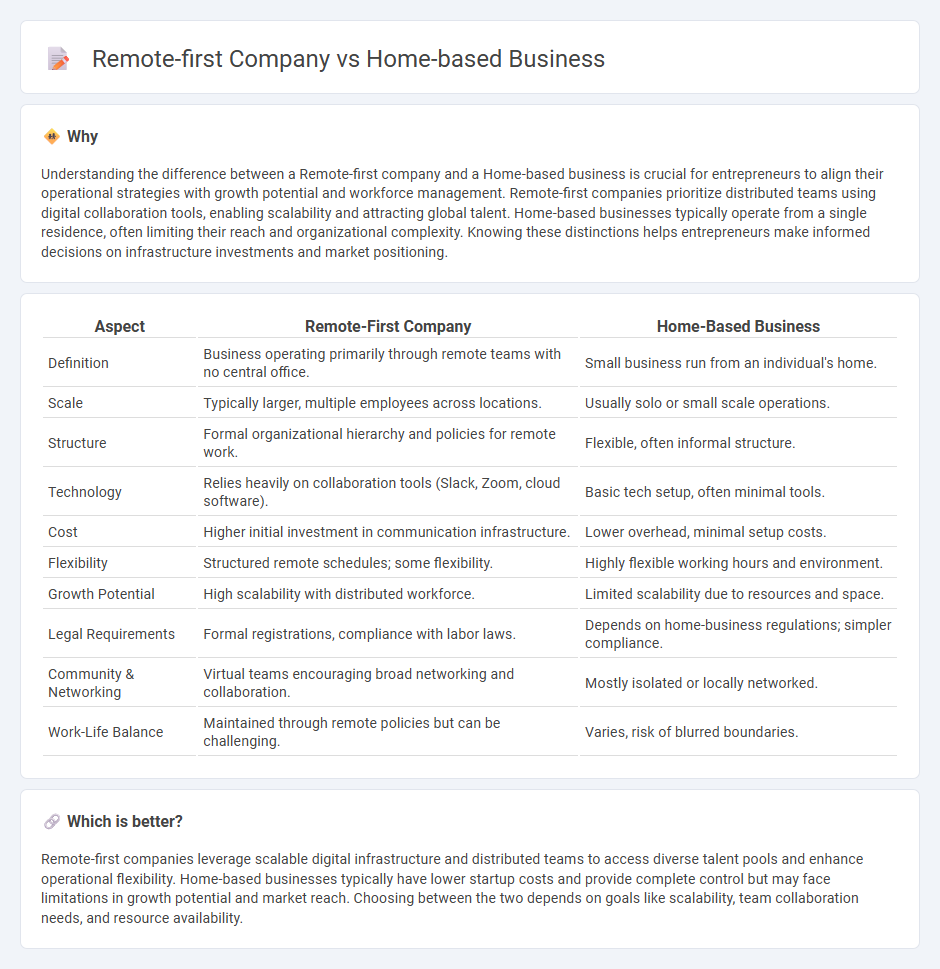
Remote-first companies prioritize flexible workspaces and leverage digital tools to operate seamlessly across multiple locations, fostering collaboration among geographically dispersed teams. Home-based businesses typically revolve around individual entrepreneurs working from their residence, often with limited scale and resources compared to remote-first models. Explore the distinct advantages and challenges of each approach to determine the best fit for your entrepreneurial goals.
Why it is important
Understanding the difference between a Remote-first company and a Home-based business is crucial for entrepreneurs to align their operational strategies with growth potential and workforce management. Remote-first companies prioritize distributed teams using digital collaboration tools, enabling scalability and attracting global talent. Home-based businesses typically operate from a single residence, often limiting their reach and organizational complexity. Knowing these distinctions helps entrepreneurs make informed decisions on infrastructure investments and market positioning.
Comparison Table
| Aspect | Remote-First Company | Home-Based Business |
|---|---|---|
| Definition | Business operating primarily through remote teams with no central office. | Small business run from an individual's home. |
| Scale | Typically larger, multiple employees across locations. | Usually solo or small scale operations. |
| Structure | Formal organizational hierarchy and policies for remote work. | Flexible, often informal structure. |
| Technology | Relies heavily on collaboration tools (Slack, Zoom, cloud software). | Basic tech setup, often minimal tools. |
| Cost | Higher initial investment in communication infrastructure. | Lower overhead, minimal setup costs. |
| Flexibility | Structured remote schedules; some flexibility. | Highly flexible working hours and environment. |
| Growth Potential | High scalability with distributed workforce. | Limited scalability due to resources and space. |
| Legal Requirements | Formal registrations, compliance with labor laws. | Depends on home-business regulations; simpler compliance. |
| Community & Networking | Virtual teams encouraging broad networking and collaboration. | Mostly isolated or locally networked. |
| Work-Life Balance | Maintained through remote policies but can be challenging. | Varies, risk of blurred boundaries. |
Which is better?
Remote-first companies leverage scalable digital infrastructure and distributed teams to access diverse talent pools and enhance operational flexibility. Home-based businesses typically have lower startup costs and provide complete control but may face limitations in growth potential and market reach. Choosing between the two depends on goals like scalability, team collaboration needs, and resource availability.
Connection
Remote-first companies and home-based businesses both prioritize location independence, enabling entrepreneurs and employees to operate outside traditional office environments. These models leverage digital tools and flexible work arrangements to enhance productivity, reduce overhead costs, and tap into global talent pools. The synergy between remote-first strategies and home-based business operations fosters innovation, scalability, and a more inclusive entrepreneurial ecosystem.
Key Terms
Scalability
Home-based businesses often face scalability challenges due to limited resources and infrastructure, restricting rapid growth and market reach. Remote-first companies leverage distributed teams and cloud technologies to scale operations efficiently across global markets, enhancing flexibility and talent acquisition. Explore how remote-first strategies can unlock scalable growth beyond traditional home-based business models.
Communication tools
Home-based businesses often rely on basic communication tools such as email, phone calls, and occasional video conferencing to coordinate tasks and maintain client relationships. Remote-first companies invest in advanced, integrated platforms like Slack, Microsoft Teams, or Zoom that foster real-time collaboration, streamline workflows, and support distributed teamwork across multiple time zones. Explore the best communication solutions tailored for your business model to optimize productivity and connectivity.
Source and External Links
What is a Home-Based Business? | Justin Welsh - A home-based business is operated from the owner's residence and can be either online, offering global reach and lower startup costs, or offline, focusing on personalized, local services with possibly higher startup capital needs.
40 Home Business Ideas for 2025 (+ How To Get Started) - Shopify - Home businesses can vary widely from selling products online, providing specialized services, starting dropshipping, or print-on-demand stores, with marketing through digital strategies and awareness of legal requirements being key for success.
Home business - Wikipedia - A home business is typically a small business run from the owner's home, often with a few family employees, lacking physical storefronts, and benefiting from lower operating costs aided by modern internet technology.
 dowidth.com
dowidth.com